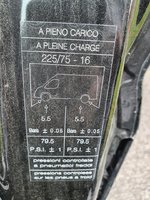ActiveCampers
Full Member
- Messages
- 280
Funny thread to appear
My van, a MY20 MH2 Ducato, now the build was finished and weighed, and a debate "elsewhere", I decided to do some digging
I've called Continental who must be the most authoritative on this and had a really good chat with their technical guy about the vehicle and tyres - and both Fiat and the website calculator are well off (!)
My details
This shows the pressure should be 3bar (42.5psi) - which is good for 1725kg axle loading, so is the same for front and rear.
What is confusing, is he said Fiat give pressures to the maximum axle weight which on my van is 2000kg - and at that the pressure should be 3.75 bar (55psi). 5 bar, as recommended by fiat, is for axle of 2600kg which is far in excess of the vans rating. Even 4.5bar for the front is 600kg higher than the front axle rating.. He also said the pressure is based on weight - so why the tyresafe website has different pressure for F/R with the same load is odd.
Very odd.
So the final results
My van, a MY20 MH2 Ducato, now the build was finished and weighed, and a debate "elsewhere", I decided to do some digging
I've called Continental who must be the most authoritative on this and had a really good chat with their technical guy about the vehicle and tyres - and both Fiat and the website calculator are well off (!)
My details
- Continental VanContact4Season
- 225/75/R16C 121/120 load
- Front axle weight (pre packing) 1560kg
- Read axle weight (pre packing) 1440kg
- Loaded, with water, bikes, and stuff, would expect
- Front axle: 1650kg
- Rear Axle: 1700kg
This shows the pressure should be 3bar (42.5psi) - which is good for 1725kg axle loading, so is the same for front and rear.
What is confusing, is he said Fiat give pressures to the maximum axle weight which on my van is 2000kg - and at that the pressure should be 3.75 bar (55psi). 5 bar, as recommended by fiat, is for axle of 2600kg which is far in excess of the vans rating. Even 4.5bar for the front is 600kg higher than the front axle rating.. He also said the pressure is based on weight - so why the tyresafe website has different pressure for F/R with the same load is odd.
Very odd.
So the final results
- Fiat: F 65psi R 73psi
- https://www.tyresafe.org/motorhome-tyre-pressure/ F: 51psi R 59psi
- Continental: 44psi F & R


